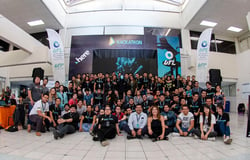. 1. Layered Architecture
- Presentation Layer:
- Technologies: Java-based frameworks like Spring MVC or JSF (JavaServer Faces).
- Purpose: Handles the user interface and user interactions. It communicates with the service layer to fetch or update business data.
- Key Features: Responsive UI, security (authentication, authorization), input validation, and client-side performance optimizations.
- Service Layer:
- Technologies: Spring Boot, Spring REST, JAX-RS (Java API for RESTful Web Services).
- Purpose: Manages business logic and acts as the intermediary between the presentation layer and the business process management layer.
- Key Features: Implements business services, manages transactions, and ensures service orchestration for business processes.
- BPM Layer:
- Technologies: JBPM (Java Business Process Model), Camunda, or Flowable.
- Purpose: This layer handles workflow automation and business process management. It defines, executes, and monitors business processes.
- Key Features: BPM engine for managing process flows, rules-based decision making, task assignment, and workflow orchestration.
- Integration: Direct integration with the service layer to implement business logic and interact with external services or databases.
- Business Rules Layer:
- Technologies: Drools, Camunda DMN (Decision Model and Notation).
- Purpose: Handles business rules and decision logic.
- Key Features: Allows business analysts to modify rules without deep coding knowledge. Provides flexibility in managing business logic separately from the core application code.
- Data Access Layer:
- Technologies: JPA (Java Persistence API), Hibernate, Spring Data JPA.
- Purpose: Manages interactions with the database and ensures persistence of business data and process states.
- Key Features: Database CRUD operations, data caching, and optimized query execution.
- Database Layer:
- Technologies: Relational Databases (MySQL, PostgreSQL) or NoSQL Databases (MongoDB, Cassandra).
- Purpose: Stores business process data, workflow states, and business entities.
- Key Features: Data persistence, scalability, and performance tuning to handle large volumes of transactions.
2. Integration and Messaging
- Integration Layer:
- Technologies: Spring Integration, Apache Camel, Enterprise Service Bus (ESB).
- Purpose: Facilitates integration with external systems (e.g., CRM, ERP, payment gateways).
- Key Features: Supports message routing, protocol translation, data transformation, and message filtering.
- Messaging Layer:
- Technologies: Apache Kafka, RabbitMQ, ActiveMQ.
- Purpose: Manages asynchronous communication and event-driven processes between systems.
- Key Features: Event-driven architecture, message queuing, and pub-sub model to handle business event notifications and workflow triggering.
3. Workflow Orchestration and Monitoring
- Orchestration Engine:
- Technologies: Camunda BPM, JBPM, Apache Camel.
- Purpose: Automates the coordination of services, tasks, and events in the business process workflow.
- Key Features: Provides a graphical interface for process modeling, integration with BPMN (Business Process Model and Notation), and orchestration of tasks.
- Monitoring and Analytics:
- Technologies: Grafana, Prometheus, Kibana (for logging and monitoring), Camunda Optimize.
- Purpose: Provides insights into business processes and workflows, identifying bottlenecks and tracking KPIs.
- Key Features: Real-time monitoring of process performance, error tracking, and process optimization suggestions.
4. API Gateway and Microservices Architecture
- API Gateway:
- Technologies: Spring Cloud Gateway, Netflix Zuul, Kong.
- Purpose: Manages incoming API requests, handles routing, and provides a security layer.
- Key Features: Load balancing, rate limiting, security, and API versioning.
- Microservices Layer:
- Technologies: Spring Boot Microservices, Docker, Kubernetes.
- Purpose: Break down the application into loosely coupled services that can be independently developed, deployed, and scaled.
- Key Features: Each microservice encapsulates specific business functions (e.g., claims processing, policy management, user management) and communicates via APIs.
5. Security and Authentication
- Security Layer:
- Technologies: Spring Security, OAuth2, JWT (JSON Web Tokens).
- Purpose: Ensures authentication, authorization, and data encryption.
- Key Features: Implements role-based access control (RBAC), secure API authentication, and data encryption both at rest and in transit.
6. Deployment and CI/CD
- Continuous Integration/Continuous Deployment (CI/CD):
- Technologies: Jenkins, GitLab CI, CircleCI, Docker, Kubernetes.
- Purpose: Automates the build, test, and deployment pipeline to ensure continuous delivery of features and updates.
- Key Features: Automated testing, code quality checks, containerized deployments, and rollback mechanisms.
Top Skills
What We Do
Unison Consulting was launched in Singapore on September 2012, the hub of the financial industry, with innovative visions in the technocratic arena. We are a boutique next-generation Technology Company with strong business-interests in Liquidity risk, Market Risk, Credit Risk and Regulatory Compliance.
Unison provides technology consulting and services to implement Risk Management and Risk Analytics System for Financial Institutions. Our services suite comprises of Techno-Functional consulting, systems integration, Business Intelligence, information management, and custom development of IT solutions, plus project management expertise for financial institutions.
We have expertise in latest cutting edge technology to achieve better total cost of ownership. Through our qualified professionals, we assist you drive your unique risk management strategies, whether that means efficient monitoring, improving risk appetite of the financial institutions, complying with regulations, or capturing growth opportunities through innovation, this is what maximizes your decision taking potential. At Unison Consulting, we view clients as partners, and our success is only measured by the success of our partners. So we put it all on the table in order to exceed expectations.
Our staff consists of young, energetic and innovative consultants who are never afraid to challenge the conventions and push the boundaries in an effort to help our clients. For every project, no matter how large or how small, we strive to not only meet your needs, but deliver a showcase in your field






.jpg)


